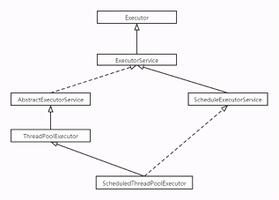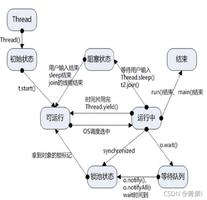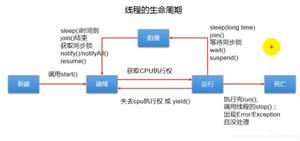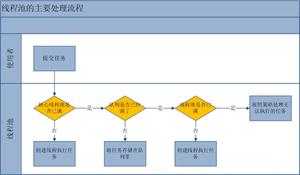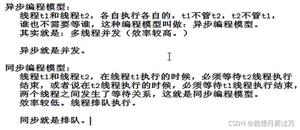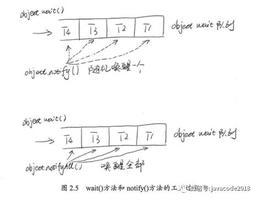[java多线程] - 锁机制&同步代码块&信号量

在美眉图片下载demo中,我们可以看到多个线程在公用一些变量,这个时候难免会发生冲突。冲突并不可怕,可怕的是当多线程的情况下,你没法控制冲突。按照我的理解在java中实现同步的方式分为三种,分别是:同步代码块机制,锁机制,信号量机制。
一、同步代码块
在java的多线程并发开发过程中,我们最常用的方式就是使用同步代码关键字(synchronized)。这种方式的使用不是特别复杂,需要注意的只是你需要明确到底同步的是那个对象,只有当同步的对象一致的情况下,才能够控制互斥的操作。一般情况下,我们会同步this或者是当前class对象。同步this对当前实例有效,同步class对当前所有class的对象有效。下面这个demo的功能是,启动十个线程,最终结果是每个线程都将共享的变量加上1.
private static final java.util.Random random = new java.util.Random(System.currentTimeMillis());public static void main(String[] args) {
Runnable runnable = new Runnable() {
private int count = 0; // 资源对象
@Override
public void run() {
try {
int oldCount = count;
Thread.sleep(random.nextInt(1000) + 10); // 处理
count = oldCount + 1;
System.out.println(Thread.currentThread().getName() + ", 原有资源:" + oldCount + ", 现在预期资源:" + (oldCount + 1) + ",现在实际资源:" + count);
} catch (InterruptedException e) {
}
}
};
for (int i = 0; i < 10; i++) {
new Thread(runnable).start();
}
}
我们可以发现结果如下图所示,明显可以看出在是个线程访问一个变量的情况下,导致最终的结果不对。
加同步锁的代码和上述代码差不多,区别只是在获取资源和修改资源的时候进行同步块处理。
int oldCount = 0;synchronized (this) {
oldCount = count;
Thread.sleep(random.nextInt(1000) + 10); // 处理
count = oldCount + 1;
}
二、锁机制
在Java中的锁机制是通过java.util.concurrent.locks.Lock来实现的,这个接口主要有三个实现类,分别是ReentrantLock,ReentrantReadWriteLock.ReadLock, ReentrantReadWriteLock.WriteLock。锁机制和同步代码块相比,我们可以明显的发现使用lock机制会降低同步粒度,提高性能。特别是在一些情况下,使用lock是一种非常不错的选择,比如说在读远远高于写的状况下,使用读写锁那是一种非常不错的选择。下面直接来一个cachedemo
1 static class CacheDemo { 2 private static final int maxSize = 100000; // 最大存储量
3 private static CacheDemo demo;
4 private Map<String, String> cache = new LinkedHashMap<String, String>() {
5 private static final long serialVersionUID = -7259602073057254864L;
6
7 protected boolean removeEldestEntry(Map.Entry<String, String> eldest) {
8 return maxSize > this.size(); // 超过就移除
9 };
10 };
11 private ReentrantReadWriteLock rrel = new ReentrantReadWriteLock();
12 private Lock writeLock = rrel.writeLock(); // 写锁
13 private Lock readLock = rrel.readLock(); // 读锁
14
15 /**
16 * 获取cache对象
17 *
18 * @return
19 */
20 public static CacheDemo instance() {
21 if (demo == null) {
22 synchronized (CacheDemo.class) {
23 if (demo == null) {
24 demo = new CacheDemo();
25 }
26 }
27 }
28 return demo;
29 }
30
31 /**
32 * 添加
33 *
34 * @param key
35 * @param value
36 */
37 public void put(String key, String value) {
38 this.writeLock.lock(); // 加锁
39 try {
40 this.cache.put(key, value);
41 } finally {
42 // 防止在操作过程中出现异常,使用try-finally保证解锁一定执行。
43 this.writeLock.unlock(); // 解锁
44 }
45 }
46
47 /**
48 * 获取这个对象
49 *
50 * @param key
51 * @return
52 */
53 public String get(String key) {
54 this.readLock.lock(); // 加锁
55 try {
56 return this.cache.get(key);
57 } finally {
58 this.readLock.unlock(); // 解锁
59 }
60 }
61
62 /**
63 * 移除key
64 *
65 * @param key
66 */
67 public void remove(String key) {
68 this.writeLock.lock();
69 try {
70 this.cache.remove(key);
71 } finally {
72 this.writeLock.unlock();
73 }
74 }
75
76 /**
77 * 清空
78 */
79 public void clean() {
80 this.writeLock.lock();
81 try {
82 this.cache.clear();
83 } finally {
84 this.writeLock.unlock();
85 }
86 }
87 }
CacheDemo
三、信号量
Java中的信号量主要有三种:Semaphore、CountDownLatch和CyclicBarrier。Semaphore可以维护访问自身的线程数,从而达到控制线程同步的需求;CountDownLatch主要作用是当计数器为0的时候,所有在该对象上等待的线程获得继续执行的权利;CyclicBarrier主要作用是当所有的线程准备好后,再允许线程执行。
1 /**2 * {@link Semaphore}
3 * 可以维护当前访问自身的线程数,并提供同步机制,使用Semahore可以控制同时访问资源的线程个数,例如:实现一个地下停车库。<br/>
4 * 单个信号变量semphore对象可以实现互斥锁的功能,并且可以是其中一个线程获得锁,另外一个线程释放锁,那么可应用于死锁恢复的一些场所。
5 *
6 * @author jsliuming
7 *
8 */
9 public class SemaphoreDemo {
10 public static void main(String[] args) {
11 ExecutorService service = Executors.newCachedThreadPool();
12 try {
13 final Semaphore semaphore = new Semaphore(3); // 3个同步变量
14 for (int i = 0; i < 10; i++) {
15 Runnable runnable = new Runnable() {
16
17 @Override
18 public void run() {
19 String name = Thread.currentThread().getName();
20 try {
21 System.out.println("线程[" + name + "]开始获取资源....");
22 semaphore.acquire(); // 请求资源,有阻塞效果
23 System.out.println("线程[" + name + "]需要的资源获取到.");
24 } catch (InterruptedException e) {
25 e.printStackTrace();
26 }
27
28 long time = (long) (Math.random() * 2000);
29 System.out.println("线程[" + name + "]已经进入,当前有:" + (3 - semaphore.availablePermits()) + "个线程运行.准备停留:" + time);
30
31 try {
32 Thread.sleep(time);
33 } catch (InterruptedException e) {
34 e.printStackTrace();
35 } finally {
36 semaphore.release(); // 放回
37 }
38 System.out.println("线程[" + name + "]运行完成!");
39 }
40 };
41 service.execute(runnable);
42 }
43 } finally {
44 service.shutdown();
45 }
46
47 }
48 }
/*** {@link CountDownLatch}
* 倒计时计时器,调用对象的countDown方法将计时器数减少一,那么直到0的时候,就会让所有等待的线程开始运行。
*
* @author jsliuming
*
*/
public class CountDownLatchDemo {
static final Random random = new Random(System.currentTimeMillis());
public static void main(String[] args) {
ExecutorService service = Executors.newCachedThreadPool();
final CountDownLatch cdOrder = new CountDownLatch(1);
int n = 3;
final CountDownLatch cdAnswer = new CountDownLatch(n);
for (int i = 0; i < n; i++) {
Runnable runnable = new Runnable() {
@Override
public void run() {
String name = Thread.currentThread().getName();
try {
System.out.println("线程[" + name + "]准备接受命令");
cdOrder.await();
long t1 = Math.abs(random.nextLong()) % 20000;
System.out.println("线程[" + name + "]已经接受到命令,处理时间需要" + t1);
Thread.sleep(t1);
System.out.println("线程[" + name + "]回应命令处理结束");
cdAnswer.countDown();
} catch (Exception e) {
e.printStackTrace();
}
}
};
service.execute(runnable);
}
try {
Thread.sleep(Math.abs(random.nextLong()) % 3000);
String name = Thread.currentThread().getName();
System.out.println("线程[" + name + "]即将发布命令");
cdOrder.countDown();
System.out.println("线程[" + name + "]已发布命令,等待结果响应");
cdAnswer.await();
System.out.println("线程[" + name + "]收到所有的响应结果");
} catch (Exception e) {
e.printStackTrace();
} finally {
service.shutdown();
}
}
}
/*** {@link CyclicBarrier}表示请大家等待,等所有集合都准备好了,那么就开始运行,这个过程可以循环。<br/>
* 比如:公司部门的周末准备一起出去游玩,先等到所有的人到达汽车才开始启动车辆到目的地去,到后自由玩,然后到1点在一起吃饭。
*
* @author jsliuming
*
*/
public class CyclicBarrierDemo {
final static Random random = new Random(System.currentTimeMillis());
public static void main(String[] args) {
ExecutorService service = Executors.newCachedThreadPool();
int n = 3;
final CyclicBarrier barrier = new CyclicBarrier(n); // 总共十个人
for (int i = 0; i < n; i++) {
Runnable runnable = new Runnable() {
@Override
public void run() {
try {
String name = Thread.currentThread().getName();
long t1 = Math.abs(random.nextLong()) % 2000;
System.out.println("线程[" + name + "] " + t1 + " 后到达集合地点1,现在已经有" + (barrier.getNumberWaiting()) + "人到达!");
Thread.sleep(t1);
System.out.println("线程[" + name + "]已经到达集合地点1,现在已经有" + (barrier.getNumberWaiting() + 1) + "人到达!");
barrier.await(); // 等待
System.out.println("线程[" + name + "]在车上...自由活动....");
t1 = Math.abs(random.nextLong()) % 2000;
System.out.println("线程[" + name + "] " + t1 + " 后到达集合地点2,现在已经有" + (barrier.getNumberWaiting()) + "人到达!");
Thread.sleep(t1);
System.out.println("线程[" + name + "]已经到达集合地点2,现在已经有" + (barrier.getNumberWaiting()) + "人到达!");
barrier.await(); // 等待
System.out.println("线程[" + name + "]觉得是美好的一天.");
} catch (Exception e) {
e.printStackTrace();
}
}
};
service.execute(runnable);
}
service.shutdown();
}
}
以上是 [java多线程] - 锁机制&同步代码块&信号量 的全部内容, 来源链接: utcz.com/z/393259.html


